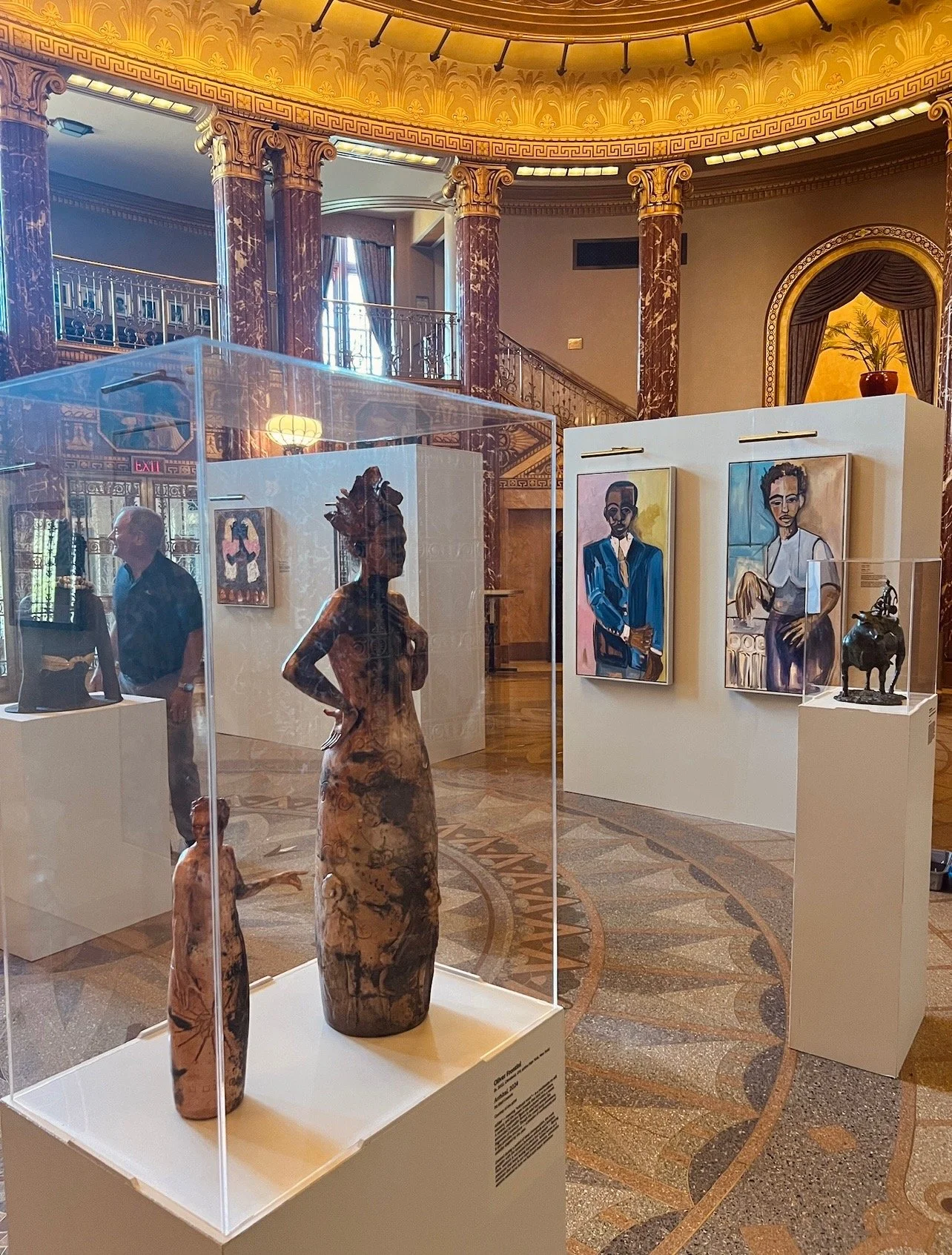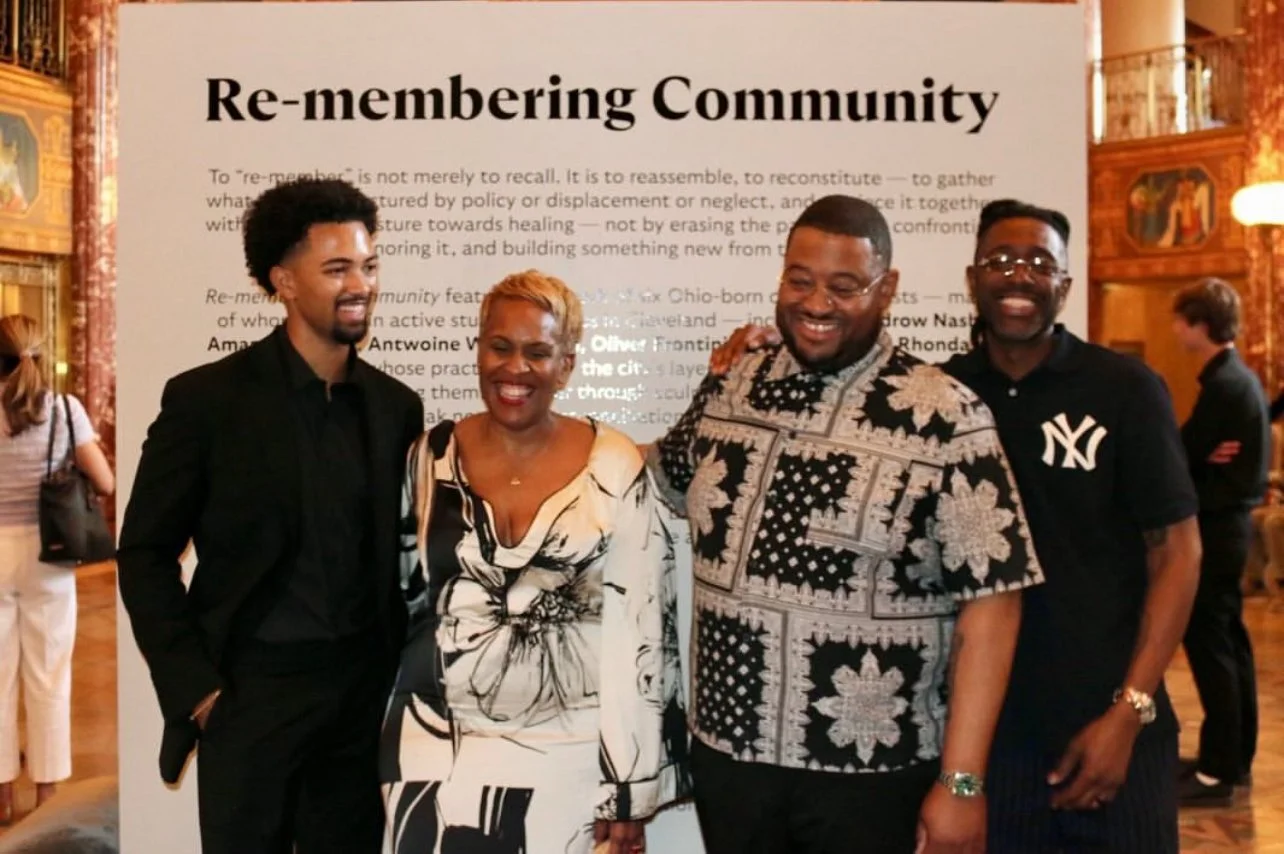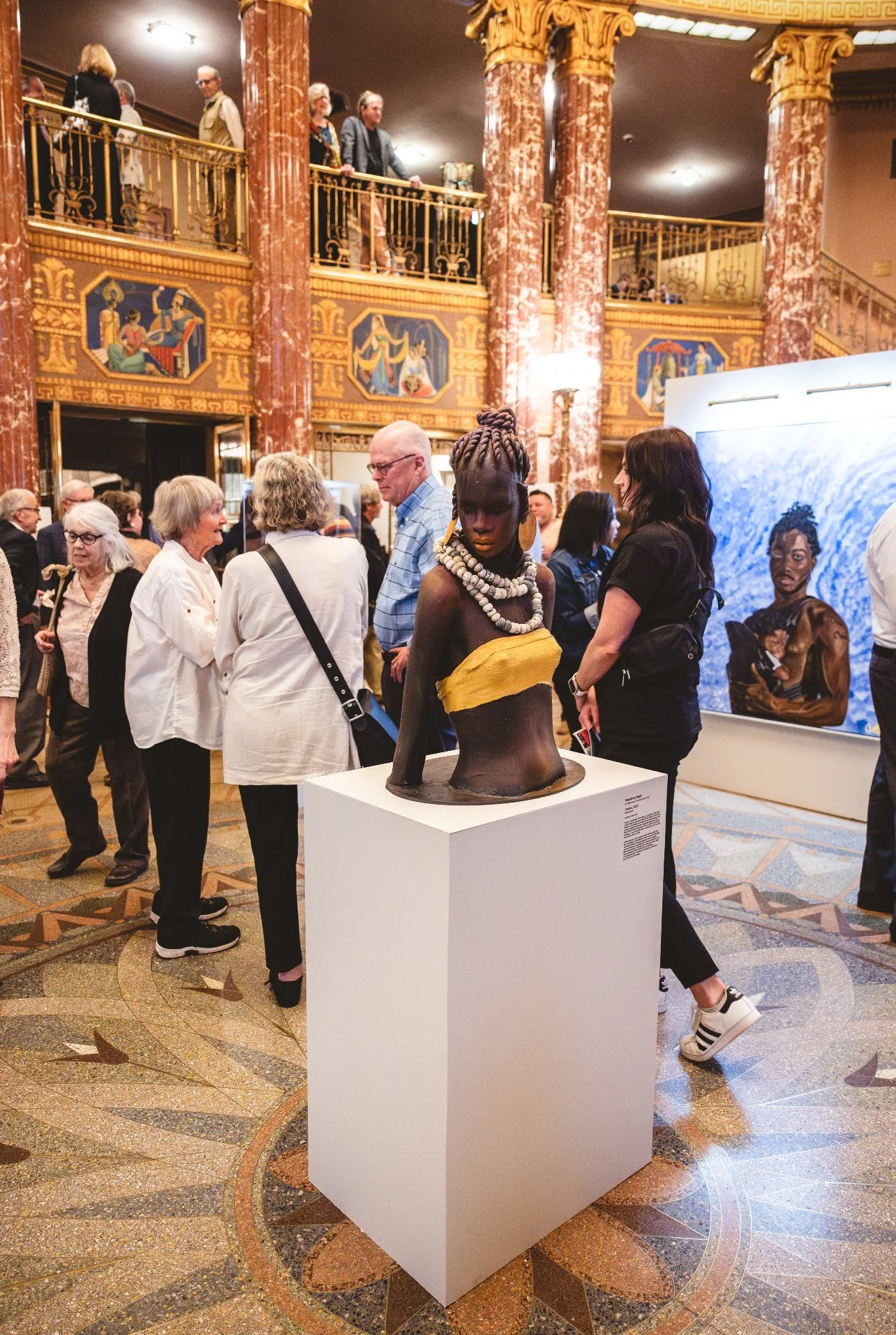Curatorial Work
Re-membering Community
Commissioned curatorial work for the Cleveland Orchestra's 2025 Mandel Opera and Humanities FestivalGuest engaging with artwork by Amanda D. King and Antwoine Washington during the opening of Re-membering Community..Installation in progress for Re-membering Community in the Bogomolny-Kozerefski Grand Foyer at Severance Music Center.Curator Toussaint J. Miller with featured artists Rhonda K. Brown, Bryan Harris, and Antwoine Washington at the opening of Re-membering Community.Installation view of Re-membering Community featuring sculpture by Woodrow Nash, with guests in attendance at Severance Music CenterGuest viewing works by Antwoine Washington and Amanda D. King during the opening of Re-membering Community.Cleveland has long been regarded as a place of confluence — for waters, for peoples, for cultures. A meeting space built by movement: of Lake Erie giving way to the Cuyahoga; of Black families fleeing the Jim Crow South during the Great Migration, carrying with them the burden of memory and the hope of possibility; of Eastern European and Latino communities arriving in pursuit of industrial promise. The city has and continues to serve as a nexus of cultural exchange and a testament to the power of collective resilience.
Re-membering Community seeks to bring this diverse tapestry into focus. The title itself is deliberate. To “re-member” is not merely to recall. It is to reassemble, to reconstitute, to gather what has been fractured by policy or displacement or neglect, and to piece it together with care. It is a gesture towards healing, not by erasing the past, but by confronting it, honoring it, and building something new from the rubble. The exhibition features the work of six Ohio-born or -based artists, many of whom maintain active studio practices in Cleveland: Woodrow Nash, Amanda D. King, Antwoine Washington, Oliver Frontini, Ryan Harris, and Rhonda K. Brown. Their practices both reflect the city’s layered histories and actively and intentionally reshape them. Their work speaks to reconciliation, yes, but also to reclamation.
Nash reclaims diasporic memory through sculptural forms that evoke both ancestral presence and futuristic imagining. King uses visual storytelling as a tool for justice, exploring themes of loss and grief. Washington paints Black familial life with radical tenderness, refusing spectacle in favor of intimacy and dignity. Frontini weaves archival material and personal history into layered compositions that explore displacement, belonging, and placemaking. Harris documents community life through photography that honors lineage and the quiet power of presence. Brown creates paintings that cement the Black form in positions of nobility.
Indeed, Re-membering Community is an exercise in “cultural equity”: the ongoing work of creating space where different voices are not simply included but valued. It is this ethic that undergirds the exhibition and promulgates the belief that art should reflect the full spectrum of a community’s truth and that artists are more than simply custodians of culture — they are architects of it. Re-membering Community insists that Cleveland’s creative voices are central to how we understand who we are.
In this vein, Re-membering Community serves as both an exhibition and an offering. It affirms that community is not static or fixed; it is something that evolves and breathes. It is among our most enduring human practices — a profound means of enacting care and cultivating belonging. At its core, this exhibit invites us not only to reflect on who we are, but to consider who we hope to become.
The Magic Lens:
A Photographic Journey by Chuck Stewart
Commissioned curatorial work for the Cleveland Orchestra's 2024 Mandel Opera and Humanities FestivalGuests viewing portraits by Chuck Stewart during the opening of The Magic Lens in the Grand Foyer of Severance Music Center.Installation in progress for The Magic Lens in the Bogomolny-Kozerefski Grand Foyer at Severance Music Center. Preparator: Mike Pelrine.Curator Toussaint J. Miller with the introductory panel for The Magic Lens: A Photographic Journey by Chuck Stewart.Toussaint J. Miller reviewing works at the Chuck Stewart Estate while finalizing selections for The Magic Lens.Cleveland Orchestra President & CEO André Gremillet in conversation with Toussaint J. Miller during the opening of The Magic Lens.At the onset of the Civil War, the abolitionist and scholar Frederick Douglass delivered a lecture on the importance of photography for justice. He argued that while combat might end geographic partition, American advancement and racial reconciliation require the use of pictures. As the most photographed American of the 19th century, it is no surprise that Douglass was well aware of the power of an image to not only influence, but altogether alter our view of the world. He knew that photography had the unique and sincere ability to depict what the eye may not see but is nonetheless present. He understood that this visual art form is so potent because it holds the potential to both honor human life and denigrate it.
Though these meditations were shared in 1861 — 114 years before the invention of the first digital camera — the dichotomy Douglass highlighted could not be any more relevant. Why is it that images of Black repose and play are so hard to come by while those depicting Black trauma and struggle seem unduly pervasive? Why aren’t Black educators depicted as frequently in books and films as Black drug addicts or slaves? Why does the contemporary American zeitgeist have such a limited view of what Black life should look like? As a young Black man attending Harvard University, where the lecture halls are buttressed by ornate portraiture of “the Greats” (few of whom are non-white, and even fewer are of African descent), I wrestle with these questions often. It has become clear to me that the reason the answers are so fleeting is because Black reality has been pigeonholed to exist at the intersection of duality; to live in the tension between bondage and freedom, between equality and a regime upholding racial hierarchy.
The Magic Lens seeks to uncloak the paradoxical relationship between how Blackness is predominantly portrayed and how it ought to be portrayed. Through the celebration of Chuck Stewart, one of the most prolific American photographers of the 20th century, this exhibition establishes a new canon of Black imagery in an artistic vernacular that seldom makes space for the Black artist. It exemplifies the way in which art can be used as a means of honoring and empowering through three guiding tenets: the power of rhythm, the power of presence, and the power of passion.
The first of the three, the power of rhythm, is apropos not only because of the many jazz musicians that make up this exhibition, but also because of the fine line they balanced between being both in and out of phase with the status quo as entertainers. Gil Scott-Heron, creator of “The Revolution Will Not Be Televised” and avid Civil Rights activist, embodied this message to the fullest. Images of luminaries including Alice Coltrane and Mary Lou Williams display the power that lies in one’s presence. These artists made space at tables that were never meant to seat them, forcefully claiming each “unalienable right” and realizing the previously unthinkable potential of American democracy by simply existing. The power of passion, the final exhibition tenet, is exemplified through portraits of Eric Dolphy, Dinah Washington, and Arvell Shaw. These creatives were steeped in the rich traditions of their crafts. They likewise understood that the beauty of Black creativity lies in its ingenuity; each iteration of an idea offers a newness that pops off the page or jumps from a rhythm that has been recycled through collective imagination.
The passion necessary to cultivate this gift, to pioneer a resolutely distinct and individual voice, required an assumption of power that was wholly and boldly self-proclaimed.
Through the work of Chuck Stewart and the artistic legacies it encapsulates, The Magic Lens exhibition is a testament to how the transformative power of photography can reshape narratives, reclaim agency, and celebrate the multifaceted richness and resilience of the Black experience.




